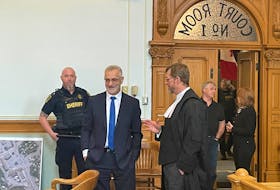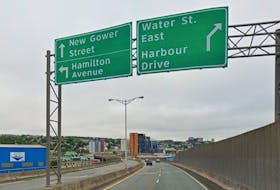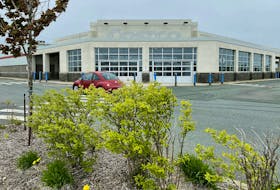It was a secret Jimmy Myrick almost took to his grave. As a boy of 14, he had taken the Titanic’s distress call on April 14, 1912.
The man on duty at Cape Race’s Marconi Wireless Station, Jack Goodwin, had apparently stepped out for a few minutes.
“Young Jimmy heard the ‘CQD, CQD. MGY. Struck iceberg. Send help right away,’ and its co-ordinates,” says Dave Myrick.
(CQD was the distress call before the days of SOS, while MGY were the letters of Titanic’s call sign).
As Jimmy’s great-nephew, Myrick is heavily involved in the events taking place at Cape Race to commemorate the 100th anniversary of the Titanic sinking.
He says according to family lore, after hearing the distress call, Jimmy ran to get Goodwin, who quickly notified Walter Gray, the station’s chief wireless operator.
The distress call was then relayed to the world via a telegraph sent through the Heart’s Content cable station.
It was the first of many communications out of Cape Race that night. The wireless station would be flooded with thousands of messages.
The Titanic sank about 370 miles from the point a couple of hours later. It took more than 1,500 souls with it, while some 700 people survived.
Myrick says everyone at the wireless station that night was sworn to secrecy.
“Young Jimmy was told, in particular, never to divulge the fact that he was left alone without a bona fide operator, not for one second,” he says.
“The Titanic’s radio operators were employees of Marconi’s. You’ve got this new technology going on at Cape Race. You can imagine the hassles that could have gotten into. … I can only speculate on what the legal aspects of it was.”
Myrick says his great-uncle went on to a career in wireless communications at sea and then in Montreal and New York.
He says Jimmy would acknowledge he was in the wireless room the night the Titanic sank, but that’s as far as he’d go — even after he had a few drinks.
“You get him juiced up pretty good, but he would never admit it,” Myrick laughs.
“And I think it was a mark of respect for all those concerned that night.”
Jimmy came close to guarding his secret forever.
But apparently he eventually shared it with another relative, who in turn told Myrick, who now feels obligated to let the world know.
“I’m not as old Irish-Catholic as they are. I don’t mind telling their story.”
The Myrick name had been synonymous with Cape Race long before April 14, 1912.
Patrick Myrick arrived as the lighthouse keeper in 1872.
He requested the job after being offered a reward for an act of bravery 11 years earlier, when he had rescued a priest who had been shot during a riot at Yellowbelly Corner in St. John’s.
Patrick Myrick ended up taking a bullet himself as he dragged the clergyman to safety.
His family would end up operating the Cape Race lighthouse until a few years ago.
They also became telegraph operators and, when the Marconi Company opened its wireless station there in 1904, they gravitated towards that technology, too.
“I’m quite proud to say there was a long line of Myricks in wireless technology who had outstanding careers,” Dave Myrick says. “I’m even more honoured to say this building is called after them. Not me — I haven’t done anything except talk.”
The building is the Myrick Wireless Interpretation Centre, a replica of Marconi’s station that sits on the same site.
The facility was being tweaked when The Telegram was there at the end of March, but by the weekend of April 14-15 it will house exhibits,
storyboards and a state-of-the-art communications setup.
It will be a focal part of this weekend’s Titanic commemorations.
The plan is to recreate some of the transmissions from April 14-15, 1912.
Cape Race will be communicating with ships at sea, people in Heart’s Content and with operators around the world.
“It’s just as an honorary thing to remember all these people,” Myrick says.
He’s been working on honouring his family and Cape Race’s Titanic connection for about a dozen years.
A humourous and jovial senior, he was raised in Cape Race and continued the family tradition with a career in ship’s communications and as a technical guy with the CBC.
“So much is not known about Cape Race. You’ve seen a lot of movies about the Titanic, but very little about Cape Race. Cape Race was the focal point of the whole thing. No one else can say we took the message from the ship and we let the rest of the world known via telegraph.”
Another important Cape Race-Titanic connection, Myrick notes, is the relationship between Gray and Jack Philips, the Titanic’s senior wireless operator.
They had attended Marconi School together in London.
“They were good friends,” Myrick says, adding they’d communicate on nights when there wasn’t a lot of sea traffic.
While he raves about Cape Race’s history, he also trumpets the fossils at neighbouring Mistaken Point.
“The only thing we haven’t got is a good well-maintained road. If we had a well-maintained road, our visitorship would be up,” he says.
In the days and weeks leading up to the 100th anniversary of the Titanic sinking, Myrick has really been kept on the hop.
The Goulds resident estimates he’s made between 10 and 15 treks to and from Cape Race in the past month.
He’s been getting the building ready and entertaining journalists from around the world.
He’s telling the Cape Race story to anyone who’ll listen, something his relative and great-uncle Jimmy may or may not have approved of.
“I kept it long enough and I hope they both forgive me. But they both know it’s true.”
Twitter: @SteveBartlett_
It was a secret Jimmy Myrick almost took to his grave. As a boy of 14, he had taken the Titanic’s distress call on April 14, 1912.
The man on duty at Cape Race’s Marconi Wireless Station, Jack Goodwin, had apparently stepped out for a few minutes.
“Young Jimmy heard the ‘CQD, CQD. MGY. Struck iceberg. Send help right away,’ and its co-ordinates,” says Dave Myrick.
(CQD was the distress call before the days of SOS, while MGY were the letters of Titanic’s call sign).
As Jimmy’s great-nephew, Myrick is heavily involved in the events taking place at Cape Race to commemorate the 100th anniversary of the Titanic sinking.
He says according to family lore, after hearing the distress call, Jimmy ran to get Goodwin, who quickly notified Walter Gray, the station’s chief wireless operator.
The distress call was then relayed to the world via a telegraph sent through the Heart’s Content cable station.
It was the first of many communications out of Cape Race that night. The wireless station would be flooded with thousands of messages.
The Titanic sank about 370 miles from the point a couple of hours later. It took more than 1,500 souls with it, while some 700 people survived.
Myrick says everyone at the wireless station that night was sworn to secrecy.
“Young Jimmy was told, in particular, never to divulge the fact that he was left alone without a bona fide operator, not for one second,” he says.
“The Titanic’s radio operators were employees of Marconi’s. You’ve got this new technology going on at Cape Race. You can imagine the hassles that could have gotten into. … I can only speculate on what the legal aspects of it was.”
Myrick says his great-uncle went on to a career in wireless communications at sea and then in Montreal and New York.
He says Jimmy would acknowledge he was in the wireless room the night the Titanic sank, but that’s as far as he’d go — even after he had a few drinks.
“You get him juiced up pretty good, but he would never admit it,” Myrick laughs.
“And I think it was a mark of respect for all those concerned that night.”
Jimmy came close to guarding his secret forever.
But apparently he eventually shared it with another relative, who in turn told Myrick, who now feels obligated to let the world know.
“I’m not as old Irish-Catholic as they are. I don’t mind telling their story.”
The Myrick name had been synonymous with Cape Race long before April 14, 1912.
Patrick Myrick arrived as the lighthouse keeper in 1872.
He requested the job after being offered a reward for an act of bravery 11 years earlier, when he had rescued a priest who had been shot during a riot at Yellowbelly Corner in St. John’s.
Patrick Myrick ended up taking a bullet himself as he dragged the clergyman to safety.
His family would end up operating the Cape Race lighthouse until a few years ago.
They also became telegraph operators and, when the Marconi Company opened its wireless station there in 1904, they gravitated towards that technology, too.
“I’m quite proud to say there was a long line of Myricks in wireless technology who had outstanding careers,” Dave Myrick says. “I’m even more honoured to say this building is called after them. Not me — I haven’t done anything except talk.”
The building is the Myrick Wireless Interpretation Centre, a replica of Marconi’s station that sits on the same site.
The facility was being tweaked when The Telegram was there at the end of March, but by the weekend of April 14-15 it will house exhibits,
storyboards and a state-of-the-art communications setup.
It will be a focal part of this weekend’s Titanic commemorations.
The plan is to recreate some of the transmissions from April 14-15, 1912.
Cape Race will be communicating with ships at sea, people in Heart’s Content and with operators around the world.
“It’s just as an honorary thing to remember all these people,” Myrick says.
He’s been working on honouring his family and Cape Race’s Titanic connection for about a dozen years.
A humourous and jovial senior, he was raised in Cape Race and continued the family tradition with a career in ship’s communications and as a technical guy with the CBC.
“So much is not known about Cape Race. You’ve seen a lot of movies about the Titanic, but very little about Cape Race. Cape Race was the focal point of the whole thing. No one else can say we took the message from the ship and we let the rest of the world known via telegraph.”
Another important Cape Race-Titanic connection, Myrick notes, is the relationship between Gray and Jack Philips, the Titanic’s senior wireless operator.
They had attended Marconi School together in London.
“They were good friends,” Myrick says, adding they’d communicate on nights when there wasn’t a lot of sea traffic.
While he raves about Cape Race’s history, he also trumpets the fossils at neighbouring Mistaken Point.
“The only thing we haven’t got is a good well-maintained road. If we had a well-maintained road, our visitorship would be up,” he says.
In the days and weeks leading up to the 100th anniversary of the Titanic sinking, Myrick has really been kept on the hop.
The Goulds resident estimates he’s made between 10 and 15 treks to and from Cape Race in the past month.
He’s been getting the building ready and entertaining journalists from around the world.
He’s telling the Cape Race story to anyone who’ll listen, something his relative and great-uncle Jimmy may or may not have approved of.
“I kept it long enough and I hope they both forgive me. But they both know it’s true.”
Twitter: @SteveBartlett_








